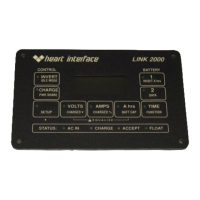5/31/96
35
output alternators are available and we strongly recommend them. With isolated
negative output alternators, remember that instrumentation and other loads grounded
directly to the engine block will not be measured unless their negatives are relocated to
the load side of the Battery Shunt. Special high current shunts are also a solution and may
be ordered from us. A separate engine starting battery whose negative is connected directly
to the engine also solves the problem.
6) We have shown several wires connected to the load side of the battery shunt in the
wiring diagram. If more than a few wires must be connected here, it is best to use a 2/0
jumper from the shunt to a good negative bus. We recommend that no more than two,
or at a maximum three, connections per large bolt be made on the negative bus side of the
shunt. The negative bus should be a solid copper or brass bar with many threaded screws
under which the negatives for all of the loads may be secured. It should be fed with a
conductor of sufficient size so that there is no appreciable voltage drop even under full load.
WIRE BY WIRE INSTALLATION
Be sure the shunt is installed before proceeding.
The BLACK WIRE (AGND) is the Analog Ground. It is the reference for all
measurements. It must be connected on the BSHG (Grounded) side of the shunt. The
BSHG side of the shunt is the side opposite of the negative battery terminals . It must have
a good connection to one of the two #10 screws on the top of the battery shunt.
The RED WIRE (+12V) is the +12V supply. (In a 24V system supply with +24V.) The
wiring diagram shows two options. The preferred option is to jumper together the RED
and BLUE wires as shown. Wired this way, the meter cannot accidentally be de-powered.
It has the disadvantage of always consuming a little bit of power from the #1 Battery. The
meter consumes about 28mA (.028A). If left on all the time it would use about 0.7 A hrs
per day.
If the system is left on for long periods (long enough to significantly discharge the
battery) with no charging sources then you should consider the option shown with the
dotted line. In this case the RED wire is
not jumped to the BLUE but supplied from the
common of the battery switch. (Be sure to install the 2A fuse as near the battery switch as
possible.) Whichever battery is selected is the battery that supplies the power. If the switch
is turned off the meter is de-powered. To resynchronize your meter you must fully charge
the battery when it is put back into service.
The WHITE WIRE supplies the display backlighting. It should be supplied from a
switch that controls other instrument lighting. It may be connected to +12 V along with
the RED wire if you wish the lighting to be on all the time. The backlighting consumes about
8mA (.008A). If left on all the time it would use less than .2Ahrs per day.
The BLUE WIRE (B1V) supplies Battery #1 Voltage for sensing. It should be supplied
directly from Battery #1. Be sure to install the 2Amp fuse shown in the drawing as near

